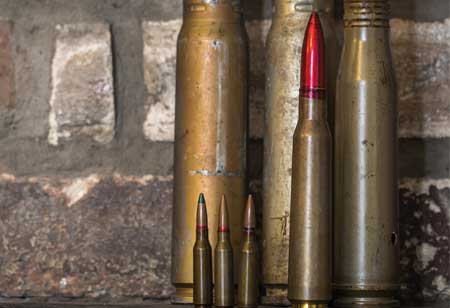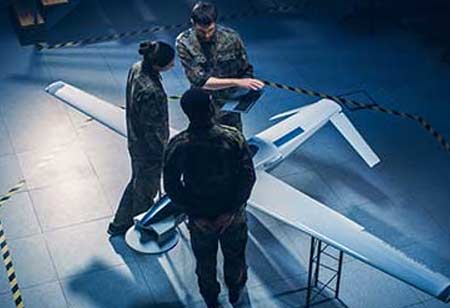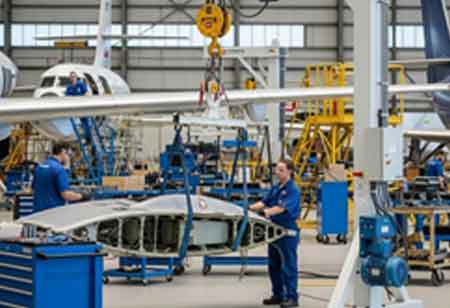Europe's aerospace and defence industries stand as pillars of technological innovation and economic stability. Central to these sectors is the production and machining of defence spare parts, vital for maintaining the operational readiness and longevity of critical systems. This industry combines high-precision manufacturing with advanced technological integration, constantly evolving to meet rigorous performance and quality standards.
The production of defence spare parts has undergone a remarkable transformation over the years. Advanced automated processes and digital technologies have supplanted mainly traditional manual machining methods. Additive manufacturing, or 3D printing, has remodelled production by enabling the creation of highly complex and durable components with remarkable efficiency. These techniques reduce lead times and introduce agility that supports on-demand production.
In addition, computer-aided manufacturing (CAM) and computer numerical control (CNC) machining have enhanced precision while minimising material waste. European manufacturers have embraced these innovations, integrating them into production facilities that prioritise rigorous quality control to align with the exacting standards of the defence sector.
Material science plays a pivotal role in developing aerospace and defence spare parts. Modern advancements have led to the widespread adoption of high-performance materials such as composites, heat-resistant alloys, and lightweight metals. Materials like titanium and carbon-reinforced composites have been particularly impactful, reducing weight while maintaining strength and durability—an essential requirement for aerospace and defence applications.
This shift toward innovative materials also reflects a growing commitment to sustainability as manufacturers adopt environmentally conscious practices that comply with stringent European regulations. Compliance with environmental standards, such as ISO 14001 and the European Union's REACH regulations, underscores the industry's commitment to legal and environmental obligations while fostering a culture of accountability and innovation. Many manufacturers strive to achieve carbon neutrality by reducing greenhouse gas emissions at their machining centres and offsetting residual emissions through certified carbon offset programs. These efforts reflect the industry's holistic approach to integrating sustainability into its operational and production frameworks. Collaboration between material suppliers and machining facilities ensures these advancements are implemented seamlessly while meeting operational and environmental standards.
Technological innovation in machining has dramatically reshaped the production of defence spare parts. High-speed machining and multi-axis capabilities enable the creation of intricate and precise designs previously unattainable through conventional methods. Laser-based machining, including laser cutting and sintering, offers unparalleled accuracy and adaptability, ensuring optimal performance in critical applications. The rise of smart manufacturing, driven by the integration of Internet of Things (IoT) devices and analytics, has further optimised production. Predictive maintenance systems, enabled by real-time machine-to-machine communication, minimise downtime and enhance operational efficiency.
Quality assurance is non-negotiable in the aerospace and defence sectors. Spare parts must meet rigorous standards due to their critical applications in systems directly tied to national security and human safety. Advanced surveillance technologies, such as coordinate measuring machines (CMM) and automated inspection systems, have improved defect detection to sub-micrometre levels, ensuring the reliability of every component.
Adopting digital twin technology has become a transformative force in spare parts production. Manufacturers can simulate various conditions by creating digital component replicas and optimising designs before production. These simulations help identify potential failure points, enabling preemptive corrections and reducing production disruptions. European machining facilities increasingly utilise digital twins, reinforcing their commitment to innovation and long-term reliability in defence applications.
The operational lifecycle of defence equipment depends heavily on the availability and reliability of spare parts. Maintenance strategies such as condition-based and predictive maintenance have gained prominence. These strategies leverage data analytics to replace parts before failure occurs. This proactive approach maximises equipment uptime while reducing operational disruptions. Additionally, spare part designs now incorporate features that simplify in-field replacement, minimising downtime and enhancing operational efficiency in aerospace and defence environments.
Collaboration among manufacturing hubs, research institutions, and industry bodies has become a cornerstone of Europe’s aerospace and defence spare parts sector. Initiatives aimed at harmonising production standards ensure interoperability across defence agencies and platforms.
Standardised protocols streamline the production process, reducing discrepancies between suppliers and assemblers while maintaining precision and quality. This collaborative framework fosters greater efficiency and enhances the sector’s capacity to meet evolving defence requirements.
Emerging trends, such as modular design in aerospace and defence systems, underscore the demand for versatile spare parts capable of performing across various platforms. Continued advancements in material science and machining technologies are necessary to meet the evolving requirements of these critical sectors.
Europe's defence spare parts production and machining sectors remain integral to bolstering national security and driving economic growth. Distinguished by innovation and a staunch commitment to precision and quality, these industries underscore the region’s leadership in the global aerospace and defence markets. As technological advancements continue to emerge, these sectors are well-positioned to adapt and prosper, establishing new standards of reliability and efficiency across diverse applications.









